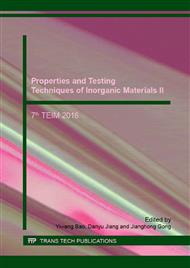p.65
p.70
p.75
p.80
p.85
p.90
p.95
p.100
p.105
Measurement of Multilayer Film Thickness Using X-Ray Fluorescence Spectrometer
Abstract:
Energy dispersive X-ray fluorescence spectrometry (EDXRF) allows a rapid determination of the concentration of elemental constituents or the thickness of thin film, it has been widely used in the industry of thin film thickness. But for multilayer film, especially the middle layer, with the absorption and enhance effect of other layers, the thickness and intensity of the middle layer is not a linear relationship. This paper reports a quantitative analysis of multilayer film thicknesses based on the use of EDXRF and fundamental parameters method. The thickness of multilayer film can be easily determined with the CTCFP software because it requires a minimum number of pure elementals only. Analysis of double-layer thin films using the CTCFP software shows that the inter-element and inter-layer X-ray absorptions and enhancements in a specimen have been determined properly. Results obtained on the standards confirmed the accuracy of the method.
Info:
Periodical:
Pages:
85-89
Citation:
Online since:
January 2017
Authors:
Keywords:
Price:
Сopyright:
© 2017 Trans Tech Publications Ltd. All Rights Reserved
Share:
Citation:


